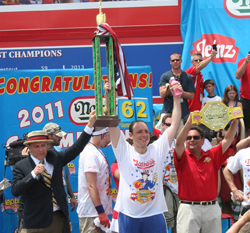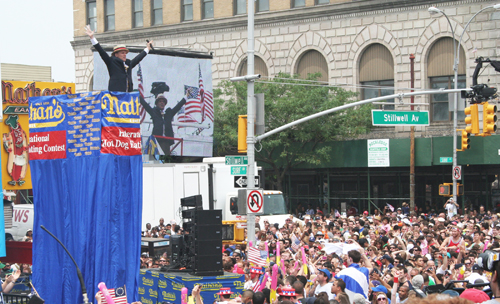
The heavy rains of the previous day were long gone and the skies crystal clear when I arrived at Coney Island in Brooklyn early on the morning of July 4 to check out the sound reinforcement for the Nathan’s Hot Dog Eating Contest.
The annual competitive-eating competition, organized by Shea Communications, features a field of about 20 contestants from the International Federation of Competitive Eating (IFOCE) converging on Nathan’s Famous Corporation’s original restaurant at the corner of Surf and Stillwell Avenues to see who can consume the most hot dogs in 10 minutes.
Held each year on the national holiday commemorating the adoption of the Declaration of Independence, the contest has reached iconic status – this year, more than 40,000 spectators were in attendance, while an additional 2 million viewers watched it live on ESPN television, joined by millions more around the world.
In this, the 96th annual run of the competition, defending champion Joey “Jaws” Chestnut won his fifth consecutive title by consuming 62 hot dogs and buns (“HDBs”) in the allotted time, while Sonya “The Black Widow” Thomas won the inaugural women’s contest in chomping down 40 HDBs.
“Today you’re going to see one of the more unusual and purely fun events on the planet,” a grinning Simon Nathan told me shortly after I arrived to a scene of dozens of workers hustling around in final preparation mode.

Nathan, a Brit by origin who owns and operates Audio Production Services of Amawalk, NY (and no relation to the Nathan’s Famous organization), is a 40-plus-year veteran of professional audio who has served as production manager for the event the past six years, including direction of the sound reinforcement.
Indeed, there’s much more to the proceedings than the copious consumption of hot dogs. Leading up to the final eat-down, there was a two-plus-hour show that included live performances by a large cover band, followed by a DJ, interspersed with guitarist and songwriter Amos Wengler performing songs he’s written for the contest (i.e., “Hot Dog Time!”, “Hot Dogs, Hot Dogs”), routines from the “Bunnettes” dance troupe, and much more, all pulled together by emcee/master of ceremonies George Shea.
It makes for a hectic experience for the crew, which is in constant reconfiguration mode throughout while also needing to factor in the demands of broadcast television in terms of sightlines and timing.
Fragmented Zones
“This thing just gets bigger and bigger,” Nathan notes. “The basic configuration has stayed the same, but the stage, press and broadcast area, in addition to the crowd, increase in size and scope every year.”
The multilevel main stage, about 90 feet long, was erected in its traditional location along the side of the restaurant on Surf Avenue, which was closed the day prior. At the same time, a media and production platform, now three levels tall, was erected across the street, and behind that is a walled-off zone where a new building is going into place.
The narrow strip of road between the stage and platform serves as the primary viewing area, but tens of thousands of people span down both Surf and Stillwell Avenues (see diagram for more on the layout).
The most significant challenge from a sound reinforcement perspective is this fragmented coverage area dictated by the physical urban surroundings of Brooklyn’s most well-known neighborhood.

“It’s not anything like a normal concert or festival situation where you’ve got a large stage in front of an unobstructed coverage area,” Nathan says. “There’s several segmented areas, and then the two main zones each stretch down streets more than a quarter of a mile.”
The loudspeaker approach this year built upon a configuration that Nathan has been evolving for several years. Platforms to the left and right of the stage (numbers 1 and 2 on the diagram) each hosted dual ground stacked line arrays – one array aimed inward to cover the front audience and the other aimed outward to handle the crowds flowing down Surf and Stillwell.
